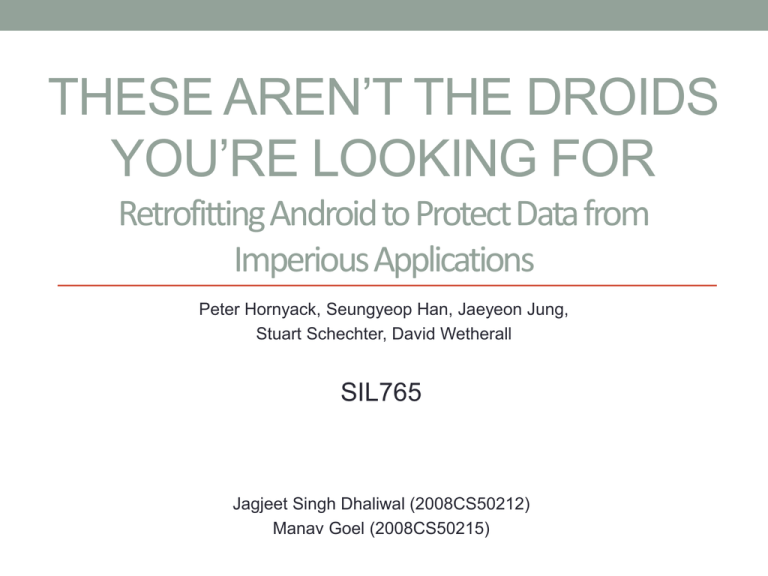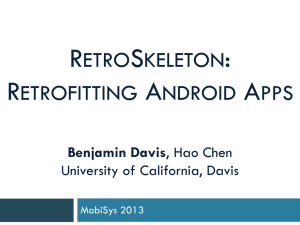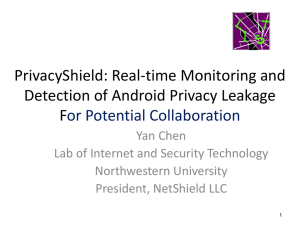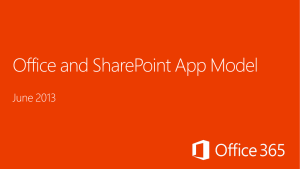These Aren*t the Droids You*re Looking For
advertisement

THESE AREN’T THE DROIDS
YOU’RE LOOKING FOR
Retrofitting Android to Protect Data from
Imperious Applications
Peter Hornyack, Seungyeop Han, Jaeyeon Jung,
Stuart Schechter, David Wetherall
SIL765
Jagjeet Singh Dhaliwal (2008CS50212)
Manav Goel (2008CS50215)
Applications can’t be trusted
Recent academic research corroborates these
findings
* Source : Wall Street Journal - http://online.wsj.com/article/SB10001424052748704368004576027751867039730.html
What is the threat?
• Android applications that
misappropriate the user’s privacysensitive data
• Transmit sensitive data that the user
intends application to use on-device only
• Transmit sensitive data to third parties
• Third parties: servers not used
directly for app functionality; but
often for advertising & analytics
Outline
• Measurement study of sensitive data usage
• AppFence: a defense against misappropriation of
sensitive data
• Framework for evaluating impact on user’s experience
• Evaluation of AppFence on 50 applications
What qualifies as “sensitive data”?
• Basically identified 12
types of privacy-sensitive
data on Android.
device id
location
phone number
contacts
camera
accounts
logs
microphone
SMS messages
history & bookmarks
calendar
subscribed feeds
How can we tell what apps are doing?
• TaintDroid: dynamic taint tracking for Android applications
[Enck et al]
loc = getLocation();
...
loc_copy = loc;
...
network_send(loc_copy);
//taint tag applied
//taint propagated
//checked for taint
Apps can’t transform, obfuscate data to remove taint
Enhance TaintDroid: added tracking for all 12 data types
Gives runtime detection of sensitive data
transmission for apps
Study of sensitive data usage
• The authors performed an extensive study of sensitive
data usage by Android apps
• 110 popular free apps from Android Market
• Selected to cover all 12 sensitive data types
• Manually executed each app for ~5 minutes
• Used TaintDroid to measure types of sensitive data sent out and
destinations sent to.
Results
For location data ( across 110 apps):
Application
Third parties
45 apps
Location?
73 apps
Of these 30 apps,
28 sent location only
to third parties!
Mobclix, Flurry,
Inmobi, AdMob
Android
Appears that some apps use
sensitive data only for purpose of
sharing with third parties.
30 apps
Could they be tracking me?
For unique device IDs (110 apps):
Application
Third parties
31 apps
Device ID?
83
apps
Android
14 apps
Just 3 third party
destinations: Mobclix,
Flurry, Freystripe
Multiple apps send device ID to same third parties: risk of
cross-application profiling is real
What else do apps misappropriate?
• Two apps sent out the user’s phone number for
no apparent reason except tracking
• Call blocking app sent out user’s entire contacts book,
then asked user to opt-in.
Sensitive data intended only for on-device use
may be sent off the device
Outline
• Measurement study of sensitive data usage
• AppFence: a defense against misappropriation of
sensitive data
• Framework for evaluating impact on user’s experience
• Evaluation of AppFence on 50 applications
Our Defense: AppFence
External
servers
Application
Android
Sensitive
data
Sensitive
data
Data
shadowing
Exfiltration
blocking
• Two complementary privacy controls:
• Shadowing: app doesn’t get sensitive data at all
• Blocking: app gets sensitive data, but can’t send it out
How data shadowing works
Application
analytics.com
(206) 555-4321
(123) 456-7890
Phone #?
(206) 555-4321
(123) 456-7890
Android
CCS - October 17-21, 2011
Shadow data
Three kinds of shadow data
• Blank data
• e.g. contacts: {S. Han, 206-555-4321} {}
• Fake data
• e.g. location: {47.653,-122.306} {41.887,-87.619}
• Constructed data
• e.g. device ID = hash(app name, true device ID)
• Consistent for each application, but different across applications
How exfiltration blocking works
analytics.com
Application
(206) 555-4321
Airplane mode:
no network
available
Phone #?
(206) 555-4321
Android
CCS - October 17-21, 2011
Outline
• Measurement study of sensitive data usage
• AppFence: a defense against misappropriation of
sensitive data
• Framework for evaluating impact on user’s experience
• Evaluation of AppFence on 50 applications
What should we measure?
• Privacy controls may cause changes in application
behavior
• The authors decided to measure the impact of AppFence
on the user’s experience.
• How did they measure this?
• Look for user-visible changes in application behavior: side effects
• Impact on whom?
An example of a side effect
• We look for user-visible changes in application
screenshots:
Framework for measuring side effects
• Automate application execution by using an Android GUI
testing program
• Converts a script of high-level commands (e.g. “press button,”
“select from menu”) into GUI interactions
• Captures screenshot after every command
• A human detects side effects by comparing screenshots
taken with and without AppFence enabled
• Classify applications based on the side effects observed:
• None
• Ads absent
• Less functional
• Broken
How we check for side effects
Baseline
AppFence
Diff
Side effect: none
Baseline
AppFence
Diff
Side effect: ads absent
Baseline
AppFence
Diff
Side effect: less functional
Baseline
AppFence
Diff
Side effect: broken
Baseline
CCS - October 17-21, 2011
AppFence
Diff
Outline
• Measurement study of sensitive data usage
• AppFence: a defense against misappropriation of
sensitive data
• Framework for evaluating impact on user’s experience
• Evaluation of AppFence on 50 applications
Experiments
• Selected 50 apps that sent out sensitive data
• Wrote execution scripts for these apps
• Exercise main features and features likely to send out sensitive
data
• Enable one AppFence privacy control, execute all
applications
• Check screenshots for side effects and classify
applications
Configuring privacy controls?
• To reveal the most side effects:
• Data shadowing of all sensitive
data types
• Exfiltration blocking of all types to
all destinations
• This imposes a policy on the
app: sensitive data should
never leave the device
• But don’t some apps have
legitimate need to send out data?
Side effects shown by 50 apps
Data
shadowing
None
Ads absent
Less functional
Broken
28 (56%)
0
Exfiltration
blocking
16 (32%)
Choose leastdisruptive
30 (60%)
(0%)
11 (22%)
3
(6%)
14 (28%)
10 (20%)
11 (22%)
8 (16%)
13 (26%)
6 (12%)
Slightly more
Choose
Remember,
the control
we
than
applied
half
thatof
acaused
single
the apps
privacy
least-severe
ran with
control
side effects
(one
limited
or or
thenoother)
for
side
each
effects
toapp:
all applications
33 apps (66%) had
no side effects or ads absent
Data shadowing was less disruptive than
We used profiling to choose; determining in
exfiltration
blocking
advance is challenging
So 34% of applications didn’t work?
• These apps had four kinds of functionality that directly
conflict with our configuration (sensitive data should never
leave the device):
• Location broadcast (location)
• Geographic search (location)
• Find friends (contacts)
• Cross-application gaming profiles (device ID)
When to use data shadowing
• Data types such as device ID, location, phone number
• Aren’t presented directly to the user
• Must be transmitted off the device
• Example application behaviors:
• Device ID sent along with login information
• Location collected at application launch
When to use exfiltration blocking
• Data types such as contacts, SMS, calendar
• Presented to the user on the device
• Don’t need to be transmitted off the device
• Example application behaviors:
• Selecting a contact to send a message to
• Adding reminders to calendar
Conclusion
• AppFence breaks the power of the installation ultimatum
• We revealed side effects by never allowing sensitive data
to leave the device
• Some apps: user must choose between functionality and
privacy
• Majority of apps: two privacy controls can prevent
misappropriation without side effects
Further Work
• Extending the Taint sources to include compression using
Java.util.zip
• Extending Data shadowing to offer finer-granularity
controls such as shadowing location with a nearby but
less private place, e.g. the city center.
Questions?






